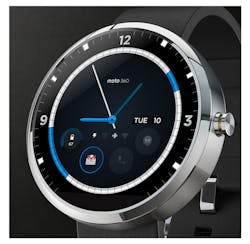Wearable technology market growth continues to rise with the proliferation of low-power micros and sensors. This includes everything from the fitness trackers that count the number of steps taken to insoles that track how you are walking. The latter adds pressure sensors to the typical list of 3D accelerometers and 3D gyroscopes.
Wearable tech brings significant benefits to applications such as medical devices. It allows a patient to be mobile and can often be used outside hospitals as well as being used 24/7, providing doctors with a tremendous amount of useful data.
Of course, there is a slew of smartwatches (Fig. 1) that will be on display at the upcoming Consumer Electronics Show, too. There is also Intel’s jeweled MICA (My Intelligent Communication Accessory) smart bracelet (see “Wearing Your Technology”). It has a curved sapphire glass touchscreen.
This wearable technology can be used in other Internet-of-Thing (IoT) applications as well. Tracking boxes, devices, and vehicles require equally compact and mobile sensors. They may require different sensors than what a personal wearable device may incorporate, but the general idea is the same.
Connectivity is a typical requirement for wearable technology and Bluetooth Low Energy (BLE) appears to be the method of choice versus something such as an 802.15.4/ZigBee or similar communication technologies. Wi-Fi tends to require too much power, although it is sometimes applicable where high bandwidth and longer distances are required.
Bluetooth has the advantage of being supported by most existing mobile devices such as smartphones and tablets. It is less common as a built-in feature in laptops and desktops, but easily added to those via a USB Bluetooth adapter. Like USB, Bluetooth has a host of standard profiles that target various application arenas.
Microcontrollers with integrated wireless support are not new, but they are becoming more common. They simplify system design and can significantly reduce the bill of materials (BOM). Often all that is added is a collection of passive components and a PCB antenna.
This file type includes high resolution graphics and schematics when applicable.
One new platform is Cypress Semiconductor’s PSoC 4 BLE. It has a hard-core BLE radio and sufficient flash storage for the Bluetooth stack that runs about 65 Kbytes. Profiles can add an additional 10 to 20 Kbytes. That still leaves good head room on the 128 Kbyte version and there is a 256 Kbyte version as well.
The PSoC platform provides designers with flexibility through configurable analog and digital components that can be combined with almost FPGA-like programmability. Almost any pin can be used as an analog input because of the pin routing matrix. This is especially useful for wearable technology that will be employing a wide range of sensors.
This Cortex-M0 PSoC can operate off coin-cell batteries. Cypress’ CapSense integration provides capacitive touch sensing support.
Another useful addition to the peripheral mix are four op-amps. These can be used individually or combined together, thereby reducing BOM costs. The BLE core only requires an antenna and two off-chip passives because the balun is built into the chip. Most other Bluetooth microcontrollers have a half dozen off-chip passive components in their BOM.
Wireless wearable tech still requires RF approval. Medical devices have additional approvals so the path to a shippable product tends to be more complex than with most other embedded devices.
At this point, a typical person may have one wearable device like a pedometer or smartwatch, but in the future it will not be uncommon to have more. Being able to control or monitor them from a single device like a smartphone will be handy and BLE may actually allow them to cooperate. But that is another story.
About the Author
William G. Wong
Senior Content Director - Electronic Design and Microwaves & RF
I am Editor of Electronic Design focusing on embedded, software, and systems. As Senior Content Director, I also manage Microwaves & RF and I work with a great team of editors to provide engineers, programmers, developers and technical managers with interesting and useful articles and videos on a regular basis. Check out our free newsletters to see the latest content.
You can send press releases for new products for possible coverage on the website. I am also interested in receiving contributed articles for publishing on our website. Use our template and send to me along with a signed release form.
Check out my blog, AltEmbedded on Electronic Design, as well as his latest articles on this site that are listed below.
You can visit my social media via these links:
- AltEmbedded on Electronic Design
- Bill Wong on Facebook
- @AltEmbedded on Twitter
- Bill Wong on LinkedIn
I earned a Bachelor of Electrical Engineering at the Georgia Institute of Technology and a Masters in Computer Science from Rutgers University. I still do a bit of programming using everything from C and C++ to Rust and Ada/SPARK. I do a bit of PHP programming for Drupal websites. I have posted a few Drupal modules.
I still get a hand on software and electronic hardware. Some of this can be found on our Kit Close-Up video series. You can also see me on many of our TechXchange Talk videos. I am interested in a range of projects from robotics to artificial intelligence.



